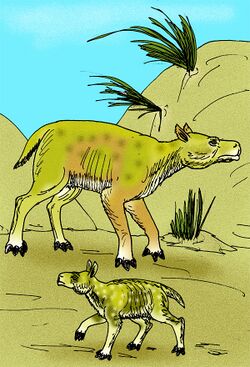Biology:Sespia
From HandWiki
Short description: Genus of mammals (fossil)
| Sespia Temporal range: Late Oligocene
| |
|---|---|

| |
| Sespia ultima and S. californica | |
| Scientific classification | |
| Domain: | Eukaryota |
| Kingdom: | Animalia |
| Phylum: | Chordata |
| Class: | Mammalia |
| Order: | Artiodactyla |
| Family: | †Merycoidodontidae |
| Tribe: | †Sespiini |
| Genus: | †Sespia Schultz & Falkenbach 1968 |
| Type species | |
| †Leptauchenia nitida | |
| Species | |
| |
| Synonyms | |
| |
Sespia ("of Sespe Creek") is an extinct genus of oreodont endemic to North America. They lived during the Late Oligocene 26.3—24.8 mya, existing for approximately 1.5 million years.[1] Sespia was cat to goat-sized and desert-dwelling.[citation needed] The genus was closely related to the larger Leptauchenia.
Fossils of the best known species, the cat-sized S. californica, have been found California and are known from literally thousands of specimens. The largest species, the goat-sized S. ultima, is known from late Oligocene deposits in Nebraska. S. ultima was once placed in a separate, monotypic, genus as Megasespia middleswarti. Other species were once placed within Leptauchenia.
References
External links
- [1] San Diego Natural History Museum "Fossil Mysteries Field Guide: Sespia californica
Wikidata ☰ Q7456090 entry

